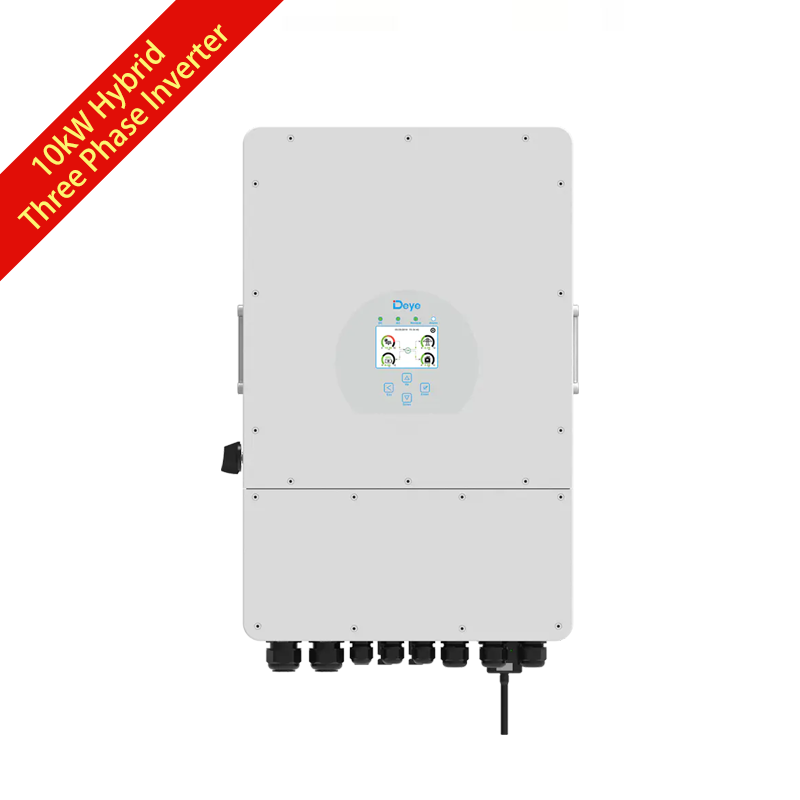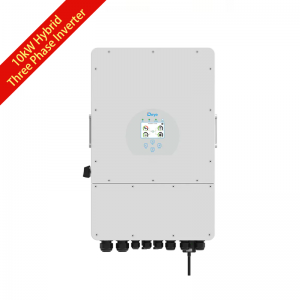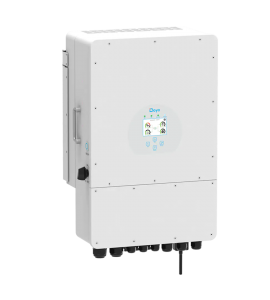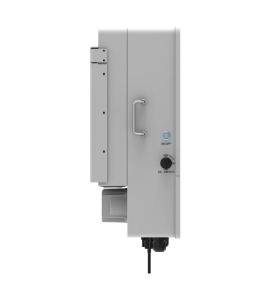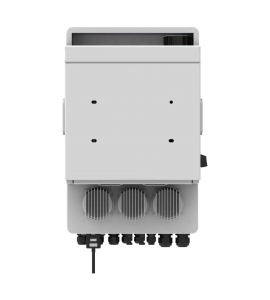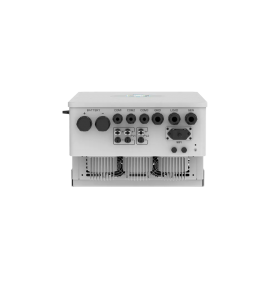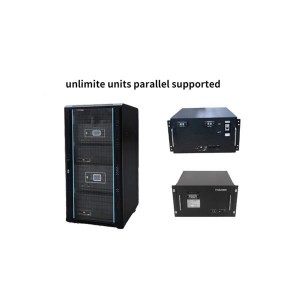

Deye 10kW Three Phase Hybrid Solar Inverter
ABOUT
Deye 10kW Three Phase Hybrid Solar Inverter
| Model | SUN-10K-SG04LP3-EU |
| Battery Input Data | |
| Battery Type | Lead-acid or Lithium-ion |
| Battery Voltage Range (V) | 40~60V |
| Max. Charging Current (A) | 210A |
| Max. Discharging Current (A) | 210A |
| Charging Curve | 3 Stages / Equalization |
| External Temperature Sensor | Yes |
| Charging Strategy for Li-Ion Battery | Self-adaption to BMS |
| PV String Input Data | |
| Max. DC Input Power (W) | 13000W |
| Rated PV Input Voltage (V) | 550V(160V~800V) |
| Start-up Voltage (V) | 160V |
| MPPT Range (V) | 200V-650V |
| Full Load DC Voltage Range (V) | 350V-650V |
| PV Input Current (A) | 26A+13A |
| Max. PV ISC (A) | 34A+17A |
| Number of MPPT / Strings per MPPT | 2/2+1 |
| AC Output Data | |
| Rated AC Output and UPS Power (W) | 10000W |
| Max. AC Output Power (W) | 11000W |
| Peak Power (off grid) | 2 times of rated power, 10 S |
| AC Output Rated Current (A) | 15.2/14.5 |
| Max. AC Current (A) | 22.7/21.7 |
| Max. Continuous AC Passthrough (A) | 45A |
| Output Frequency and Voltage | 50/60Hz;3L/N/PE 220/380Vac,230/400Vac |
| Grid Type | Three Phase |
| Current Harmonic Distortion | THD<3% (Linear load<1.5%) |
| Efficiency | |
| Max. Efficiency | 97.60% |
| Euro Efficiency | 97.00% |
| MPPT Efficiency | 99.90% |
| Protection | |
| PV Input Lightning Protection | Integrated |
| Anti-islanding Protection | Integrated |
| PV String Input Reverse Polarity Protection | Integrated |
| Insulation Resistor Detection | Integrated |
| Residual Current Monitoring Unit | Integrated |
| Output Over Current Protection | Integrated |
| Output Shorted Protection | Integrated |
| Output Over Voltage Protection | Integrated |
| Surge protection | DC Type II / AC Type Ⅲ |
| Certifications and Standards | |
| Grid Regulation | CEI 0-21, VDE-AR-N 4105, NRS 097, IEC 62116, IEC 61727, G99, G98, VDE 0126-1-1, RD 1699, C10-11 |
| Safety EMC / Standard | IEC/EN 61000-6-1/2/3/4, IEC/EN 62109-1, IEC/EN 62109-2 |
| General Data | |
| Operating Temperature Range (℃) | -45~60℃, >45℃ Derating |
| Cooling | Smart cooling |
| Noise (dB) | <45 dB |
| Communication with BMS | RS485; CAN |
| Weight (kg) | 33.6 |
| Size (mm) | 422W×699.3H×279D |
| Protection Degree | IP65 |
| Installation Style | Wall-mounted |
| Warranty | 5 years |
What is the difference between a solar inverter and a hybrid inverter?
As we all know, they are designed to convert direct current into alternating current. It's worth noting that for the panels to generate electricity, it definitely needs to go through a solar inverter.
Both of them are widely used in the conversion of photovoltaic solar energy into electricity. Even some hybrid solar inverters can use a combination of solar and wind, or off-grid and grid-tied.
What we call a generalized solar inverter is not just a product. It is not easy to explain its use literally, because there are differences in the scope of their use, such as function, structure, technology, and even appearance design.
Therefore, we can simply understand it as the inverter connected to the photovoltaic solar energy system.
And in the usage habits of most regions, solar products are more commonly known as battery backup product or battery product, where electrical energy converted from photovoltaic solar energy is stored by a battery pack. After that, all power is supplied from the battery side to the AC/DC load through the connected inverter.
In other words, battery transfers electrical energy from a charger to a load or grid. And most battery backup products are capable of providing AC power in the event of a power outage or blackout.
Whereas a hybrid solar inverter is an upgrade based on a solar one. It incorporates the functionality of a solar product, converting DC to AC, and also adds a built-in solar controller, such as MPPT or PWM type. So, to be precise, a hybrid one is a solar product with a built-in charge controller. It can also be a combination of off-grid one and grid-tied one in a machine, the description is the same as what you call a hybrid solar inverter.
